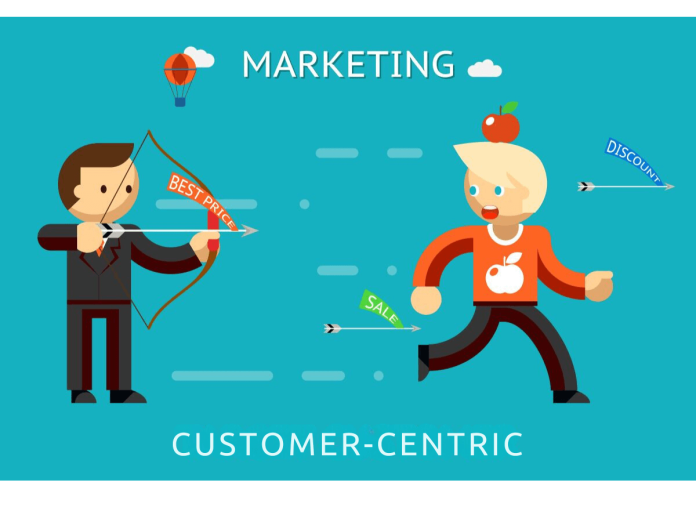In a world where customers have more choices than ever, standing out means putting your customers at the heart of your marketing strategy. Customer-Centric Marketing (CCM) is all about tailoring your approach to meet your customers’ needs, desires, and pain points.
Focusing on your customers not only makes their experience better but also sets the stage for your business to grow. Let’s dive into what CCM is, why it’s important, and how you can use it to drive your business forward.
1# What is Customer-Centric Marketing?
Imagine walking into a store where the staff immediately knows what you’re looking for, offers relevant recommendations, and genuinely cares about your needs. That’s the essence of Customer-Centric Marketing. Instead of focusing solely on what you’re selling, CCM is about understanding your customers deeply and crafting marketing efforts that resonate with them personally.
It’s about listening to your customers, understanding their preferences and challenges, and using that insight to create tailored marketing messages and experiences. This approach ensures that every interaction with your brand feels relevant and valuable to the customer.
2# Why Focusing on Your Customers Drives Business Success
Building Loyalty: When customers feel understood and valued, they’re more likely to stick around. Customer-Centric Marketing helps forge stronger relationships, leading to greater loyalty and repeat business.
Creating Better Experiences: Your clients will receive more interesting and satisfying experiences if you put their needs first. Pleased clients are more inclined to tell others about their good experiences, which can improve your reputation and attract new clients.
Boosting Conversions: Personalized marketing messages that address specific customer needs can drive higher conversion rates. When customers see that your offerings match their needs, they’re more inclined to make a purchase.
Gaining a Competitive Edge: In a crowded marketplace, standing out is crucial. A customer-centric approach differentiates your brand by showing that you genuinely care about your customers’ experiences and satisfaction.
3# Key Components of a Customer-Centric Marketing Strategy
Understanding Your Customers: Start by getting to know your customers better. Use surveys, interviews, and data analytics to gather insights about their preferences, behaviors, and pain points.
Personalization: Tailor your marketing messages and offers to fit individual customer profiles. This could be through personalized emails, targeted social media ads, or customized recommendations on your website.
Mapping the Customer Journey: Identify the key stages your customers go through, from discovering your brand to making a purchase and beyond. Understanding these stages helps you create a smoother and more relevant customer experience.
Gathering Feedback: Regularly seek feedback from your customers to understand their evolving needs and preferences. Use this feedback to continually refine and improve your marketing strategies.
4# Customer-Centric Marketing Examples
Amazon: Think of how Amazon seems to always know what you might want to buy next. Their recommendation engine analyzes your browsing and purchase history to suggest products that are relevant to you.
Netflix: Netflix’s ability to recommend shows and movies based on your viewing history keeps you coming back for more. Their personalized approach makes your streaming experience feel tailored just for you.
Sephora: Sephora’s Beauty Insider program offers personalized product recommendations and rewards based on your purchase history. This program enhances customer loyalty by making you feel valued and understood.
5# How to Build a Customer-Centric Marketing Strategy
1. Know Your Customers: Use data and research to understand who your customers are and what they want. This knowledge is the foundation of a successful customer-centric strategy.
2. Segment Your Audience: Group your customers into segments based on their characteristics and behaviors. This allows you to create more targeted and relevant marketing messages.
3. Personalize Your Approach: Tailor your marketing efforts to meet the specific needs and preferences of each customer segment. This can be achieved through personalized content, offers, and interactions.
4. Map Out the Customer Journey: Identify the key touchpoints where customers interact with your brand. Ensure that each touchpoint provides a positive and relevant experience.
5. Test and Refine: Implement your strategies and monitor their performance. Continuously test different approaches and refine your strategies based on what works best.
6. Collect and Act on Feedback: Regularly seek feedback from your customers and use it to make improvements. This helps you stay aligned with their needs and enhance their overall experience.
6# How Technology Can Elevate Your Customer Experience
Data Analytics: Advanced analytics tools provide insights into customer behavior and preferences, helping you make more informed marketing decisions.
AI and Machine Learning: AI can predict customer needs and automate personalized marketing efforts, making your campaigns more efficient and effective.
CRM Systems: Customer Relationship Management (CRM) systems offer a complete view of customer interactions, helping you deliver more personalized and relevant experiences.
Marketing Automation: Automation tools streamline your marketing processes, allowing you to deliver timely and relevant messages based on customer behavior.
7# Measuring What Matters – How to Track Success
Customer Satisfaction Scores: Metrics like Net Promoter Score (NPS) and Customer Satisfaction Score (CSAT) help you gauge how well your marketing strategies are meeting customer expectations.
Conversion Rates: Track how many leads turn into customers. A higher conversion rate indicates that your personalized marketing efforts are working.
Customer Retention Rates: Measure how many customers return after their first purchase. Improved retention rates are a sign of successful customer-centric strategies.
Engagement Metrics: Monitor how customers interact with your content, such as click-through rates and social media engagement, to assess the effectiveness of your marketing.
8# Future Trends in Customer-Centric Marketing
Hyper-Personalization: Advances in AI and machine learning will enable even more personalized experiences, offering real-time, tailored interactions based on customer data.
Experience Automation: Automation will continue to enhance customer experiences by providing timely and relevant interactions across multiple channels.
Omnichannel Integration: Ensuring a seamless customer experience across all touchpoints will become increasingly important for maintaining a consistent brand experience.
Ethical Data Practices: As data privacy concerns grow, balancing personalization with ethical data usage will be crucial for maintaining customer trust.
Conclusion
Customer-Centric Marketing (CCM) is a strategic approach that focuses on understanding and meeting customer needs. Businesses can boost customer satisfaction and growth by using technology, tracking results, and always looking for ways to improve. CCM enhances customer relationships and sets businesses up for long-term success.
I hope you find the above content helpful. For more such informative content please visit Techadvisor Pro.











